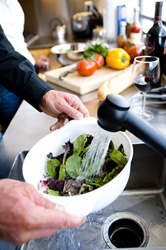The Nine Most Common Causes of Food Poisoning,
and Six Simple Tips to Stay Safe
by www.SixWise.com
Each year, food-borne illnesses result in 5,700 deaths, 371,000 hospitalizations and 87 million cases of illness in the United States, according an Associated Press calculation that used the U.S. Centers for Disease Control and Prevention’s (CDC) formula and current population estimates.

There are 87 million cases of food-borne illness every year in the United States. |
Among them, nine food-borne illnesses have occurred at a steady rate since 2004, leading Robert Tauxe, MD, MPH, deputy director of the CDC's Division of Foodborne, Bacterial, and Mycotic Diseases, to say that progress toward curbing these illnesses has “plateaued.”
The numbers come from the CDC’s Morbidity and Mortality Weekly Report, which collected data from 10 states, including their 18,499 laboratory-confirmed cases of nine food-borne illnesses in 2008.
According to the data, the nine food-borne illnesses ranked as follows:
-
Salmonella: 7,444 cases (foods typically affected include raw or contaminated meat, poultry, milk or egg yolks)
-
Campylobacter: 5,825 cases (meat and poultry)
-
Shigella: 3,029 cases (raw, ready-to-eat produce)
-
Cryptosporidium: 1,036 cases (water, fruit and salad vegetables)
-
E. coli 0157: 718 cases (beef contaminated during slaughter. Spread mainly by undercooked ground beef)
-
Yersinia: 164 cases (raw or undercooked pork products)
-
Listeria: 135 cases (Hot dogs, luncheon meats, unpasteurized milk and cheeses, and unwashed raw produce)
-
Vibrio: 131 cases (oysters and other shellfish)
-
Cyclospora: 17 cases (imported fresh produce)
Overall, the rates remained steady since 2004, leading public health experts and American consumers to wonder what else could be done to improve the safety of the food supply.
Signs and Symptoms of Food Poisoning
If you’ve eaten a contaminated food, symptoms may start within hours or hold off until days later. Symptoms, which generally last from one to 10 days, can include:
If you’re healthy, food poisoning can be self-limiting and may go away on its own. However, it can be potentially life-threatening for young children, pregnant women and their fetuses, older adults, and people with weakened immune systems.
Further, if you’re unable to keep liquids down for 24 hours, you should see a doctor right away to prevent becoming dehydrated.
Are You Confident in the Safety of Your Food Supply?
What do tomatoes, jalapeno peppers, lettuce, beef, peanut butter, alfalfa sprouts, and cookie dough all have in common? These foods have all been the recent subjects of tainted food outbreaks.
As a result of these and other highly publicized outbreaks, wary Americans have resorted to changing their buying habits, according to a US Grocery Shopper Trends report prepared by the Food Marketing Institute.

How much do you really know about food poisoning prevention? Taking this food-poisoning prevention test -- with correct answers provided at the end -- will help. Please pass it on to others who can benefit as well. |
The report found that only 66 percent of shoppers are confident that the food they buy at the grocery store is safe, down from 82 percent in 2006. And, 38 percent of consumers have stopped buying certain fresh produce and meat items, up from just 9 percent in 2006.
Still, health officials say, better testing and surveillance has actually improved the government's ability to detect food-borne disease outbreaks. However, outbreaks account for just a fraction of all food-borne illness cases; for instance, salmonella cases were only tied to an outbreak 7 percent of the time.
So what can you do to make your food safer 100 percent of the time?
Tips for Preventing Food Poisoning, and What to do If You Get a Food-Borne Illness
The Mayo Clinic recommends the following six tips to help prevent food poisoning:
-
Wash your hands, utensils and food surfaces often.
-
Keep raw foods separate from ready-to-eat foods when shopping, preparing food or storing food.
-
Cook foods to a safe temperature. You can kill harmful organisms in most foods by cooking them to temperatures between 145 F (62.8 C) and 165 F (73.9 C).
-
Refrigerate or freeze perishable foods promptly (within two hours of purchasing or preparing them).
-
Defrost food safely. Do not thaw foods at room temperature. The safest way to thaw foods is to defrost foods in the refrigerator or to microwave the food using the "defrost" or "50 percent power" setting. Running cold water over the food also safely thaws the food.
-
Throw it out when in doubt. If you aren't sure if a food has been prepared, served or stored safely, discard it.
Is Your Gut Strong Enough to Fight Off a Food-Borne Illness?
You can help fortify your gut health with Nature’s Sources AbsorbAid Probiotic --a superlative probiotic supplement that provides clinical activities supporting systemic health and wellness through immune-system protection, allergy reduction and effective and enhanced nutrient absorption.
With 30 billion organisms per capsule, AbsorbAid Probiotic is one of the most potent and cost-effective probiotics on the market today.
Studies have shown that probiotics may be helpful with:
|
Of course, even with the best intentions and hygiene it’s still possible to be exposed to a contaminated food. And this is why many natural health experts recommend keeping your digestive system in top working order at all times.
Why? Because 70 percent of your immune system is located in your digestive system, which means that if your gut is overrun with bad bacteria, there’s a good chance your immune system will not be functioning at its best.
On the other hand, if your gut is being fortified with good bacteria, or probiotics, your immune system will be fully functioning and have the best chance of fighting off any disease-causing bacteria it encounters.
In choosing a probiotic supplement for yourself, Sixwise.com highly recommends Nature’s Sources AbsorbAid Probiotic -- a superlative probiotic supplement that provides clinical activities supporting systemic health and wellness through immune-system protection, allergy reduction and effective and enhanced nutrient absorption.
AbsorbAid Probiotic has 30 billion organisms per capsule, with two clinically effective and dominant genera Bifidobacterium and Lactobacillus: L. acidophilus and L. salivarius in a 2:1 ratio and B. lactis and B. breve, also in a 2:1 ratio. Each bacterial genus-species has its own specific metabolic activities, which lead to their effective inter-species synergism.
Probiotics not only help to keep your digestive health in working order, but they may also help you to ward off food poisoning if you get it. According to one study by Irish scientists, pigs receiving probiotics had reduced incidence, severity and duration of diarrhea after being infected with salmonella.
So if you suspect you have come down with a food-borne illness, having probiotics on hand and taking a generous dose is a simple, and safe, remedy to try. However, if your symptoms persist make sure to see your doctor.
Recommended Reading
Food Manufacturers Won’t Guarantee Your Foods’ Safety
How Long Before Different Refrigerated Foods Spoil (& Other Secrets to Your Refrigerator)
Sources
WebMD.com April 9, 2009
MSNBC.com April 9, 2009
Foodnavigator-USA.com
NutraIngredients.com March 20, 2007
MayoClinic.com Food Poisoning